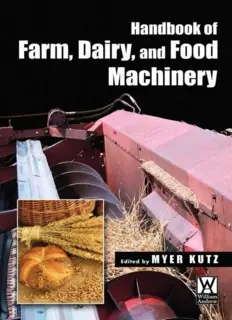
Handbook of Farm, Dairy, and Food Machinery PDF
Preview Handbook of Farm, Dairy, and Food Machinery
This page intentionally left blank Handbook of Farm, Dairy, and Food Machinery Edited by Myer Kutz Myer Kutz Associates, Inc. Delmar, New York This page intentionally left blank Copyright ©2007 by William Andrew, Inc. No part of this book may be reproduced or utilized in any form or by any means, electronic or mechanical, including photocopying, recording, or by any information storage and retrieval system, without permission in writing from the Publisher. Cover by Hannus Design ISBN: 978-0-8155-1538-8 (William Andrew, Inc.) ISBN: 3-540-21117-9 (Springer B. V.) Library of Congress Cataloging-in-Publication Data Handbook of farm, dairy, and food machinery / edited by Myer Kutz. p. cm. Includes bibliographical references and index. ISBN-13: 978-0-8155-1538-8 (978-0-8155 : alk. paper) ISBN-10: 0-8155-1538-3 (0-8155 : alk. paper) 1. Food processing machinery–Handbooks, manuals, etc. 2. Farm equipment–Handbooks, manuals, etc. 3. Dairying–Equipment and supplies–Handbooks, manuals, etc. I. Kutz, Myer. TP370.4.H3578 2007 664′.02–dc22 2006103074 Printed in the United States of America This book is printed on acid-free paper. 10 9 8 7 6 5 4 3 2 1 Co-published by: William Andrew Publishing 13 Eaton Avenue Springer B. V. Norwich, NY13815 Van Godewijckstraat 30 Sina Ebnesajjad, Editor in Chief 3300 AADordrecht (External Scientific Advisor) The Netherlands 1-800-932-7045 www.springer.com www.williamandrew.com (Orders from outside North and Latin America) (Orders from all locations in North and Latin America) NOTICE To the best of our knowledge the information in this publication is accurate; however the Publisher does not assume any responsibility or liability for the accuracy or completeness of, or consequences arising from, such information. This book is intended for informational purposes only. Mention of trade names or commercial products does not constitute endorse- ment or recommendation for their use by the Publisher. Final determination of the suitability of any information or product for any use, and the manner of that use, is the sole responsibility of the user. Anyone intending to rely upon any recom- mendation of materials or procedures mentioned in this publication should be independently satisfied as to such suitability, and must meet all applicable safety and health standards. To Alan and David, for all the good times at Ichiban This page intentionally left blank Table of Contents Contributors................................................................................................................... xxv Preface...........................................................................................................................xxvii PART 1 INTRODUCTION TO FOOD ENGINEERING...................................... 1 1 The Food Engineer................................................................................................ 3 Felix H. Barron 1.1 Nature of Work and Necessary Skills.......................................................... 3 1.2 Academic and Industry Preparation............................................................. 4 1.3 Work Opportunities for a Food Engineer.................................................... 7 1.3.1 Job description sample 1................................................................ 7 1.3.2 Job description sample 2................................................................ 8 1.3.3 Job description sample 3................................................................ 9 1.3.4 Job description sample 4................................................................ 9 1.3.5 Job description sample 5................................................................ 10 1.4 Engineering Jobs.......................................................................................... 12 1.5 Future Opportunities..................................................................................... 14 1.6 Conclusions................................................................................................... 14 References................................................................................................................ 14 2 Food Regulations................................................................................................... 15 Kevin M. Keener 2.1 Background................................................................................................... 15 2.1.1 Federal Register.............................................................................. 16 2.1.2 United States Code......................................................................... 17 2.2 Sanitation Programs...................................................................................... 18 2.2.1 Sanitation........................................................................................ 18 2.3 Hazard Analyses and Critical Control Point Program (HACCP)................ 20 2.3.1 Prerequisite programs..................................................................... 21 2.4 Current Good Manufacturing Processes (cGMP)........................................ 22 2.5 Meat Processing............................................................................................ 24 2.6 Shell Eggs..................................................................................................... 26 2.6.1 Egg products................................................................................... 27 2.7 Seafood Processing....................................................................................... 27 2.8 Fruits, Vegetables, and Nuts......................................................................... 29 vii viii Table of Contents 2.9 Beverages...................................................................................................... 29 2.9.1 Alcoholic beverages....................................................................... 29 2.9.2 Carbonated beverages..................................................................... 30 2.9.3 Bottled water.................................................................................. 30 2.9.4 Fruit and vegetable juices............................................................... 31 2.9.5 Pasteurization.................................................................................. 32 2.9.6 Milk and milk products.................................................................. 33 2.10 Canned Foods............................................................................................... 34 2.11 Foodservice/Restaurants............................................................................... 35 2.12 Export Foods................................................................................................ 35 2.13 Imported Foods............................................................................................. 36 2.14 Organic Food Processing.............................................................................. 38 2.15 Conclusions................................................................................................... 39 References................................................................................................................ 39 Acronyms................................................................................................................. 42 3 Food Safety Engineering....................................................................................... 45 Raghupathy Ramaswamy, Juhee Ahn, V. M. Balasubramaniam, Luis Rodriguez Saona, and Ahmed E. Yousef 3.1 Introduction................................................................................................... 45 3.2 Intervention Technologies............................................................................ 46 3.2.1 Novel non-thermal intervention technologies................................ 46 3.2.2 Chemical interventions................................................................... 50 3.2.3 Hurdle approach............................................................................. 53 3.3 Control/Monitoring/Identification Techniques............................................. 54 3.3.1 Chromogenic microbiological media............................................. 54 3.3.2 Molecular and immunological assays methods............................. 55 3.3.3 Biosensors....................................................................................... 56 3.3.4 Fourier Transform Infrared spectrometry....................................... 58 3.4 Packaging Applications in Food Safety....................................................... 59 3.4.1 Active packaging............................................................................ 60 3.4.2 Intelligent or “Smart” packaging................................................... 60 3.4.3 Tamper evident packaging.............................................................. 60 3.5 Tracking and Traceability............................................................................. 61 3.6 Byproducts of Processing............................................................................. 62 3.6.1 Acrylamide..................................................................................... 62 3.6.2 3-monochloropropanediol............................................................... 63 3.7 Conclusions................................................................................................... 63 3.8 Acknowledgment.......................................................................................... 64 References................................................................................................................ 64 Table of Contents ix PART 2 FARM MACHINERYDESIGN................................................................. 71 4 Farm Machinery Automation forTillage Planting, Cultivation, and Harvesting ...................................................................................................... 73 Brian T. Adams 4.1 Introduction................................................................................................... 73 4.2 Vehicle Guidance.......................................................................................... 74 4.2.1 Guidance strategies......................................................................... 75 4.3 Implement Guidance Systems...................................................................... 80 4.4 Guidance Methods........................................................................................ 80 4.4.1 Global Positioning System (GPS).................................................. 82 4.4.2 Machine vision............................................................................... 84 4.4.3 Dead reckoning............................................................................... 85 4.4.4 Inertial............................................................................................. 85 4.4.5 Crop feelers.................................................................................... 85 4.4.6 Furrow following............................................................................ 86 4.5 Challenges Facing Autonomous Vehicles.................................................... 86 4.5.1 Safety.............................................................................................. 87 4.5.2 Liability........................................................................................... 89 4.6 Conclusions................................................................................................... 89 References................................................................................................................ 91 Other Contacts......................................................................................................... 91 5 Grain Harvesting Machinery Design.................................................................. 93 H. Mark Hanna and Graeme R. Quick 5.1 Introduction................................................................................................... 93 5.2 History ........................................................................................................ 93 5.3 Machine Design: Pre-harvest Issues............................................................ 94 5.4 Performance Factors..................................................................................... 95 5.5 Heads: Grain Platforms, Corn Heads, and Strippers................................... 95 5.6 Feederhouse.................................................................................................. 99 5.7 Cylinder or Rotor and Concave................................................................... 99 5.8 Separation: Straw Walkers and Rotary Separation...................................... 103 5.9 Cleaning Shoe............................................................................................... 104 5.10 Elevators: Clean Grain and Tailings............................................................ 106 5.11 Grain Bin and Unloading Auger.................................................................. 106 5.12 Other Attachments........................................................................................ 107 5.13 Operator’s Station, Adjustments, and Monitoring Systems......................... 109 5.14 Field Performance........................................................................................ 110 5.15 Grain Damage............................................................................................... 110
